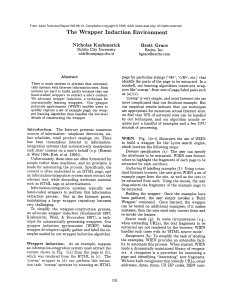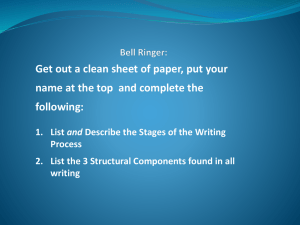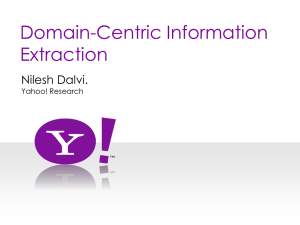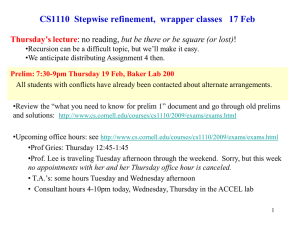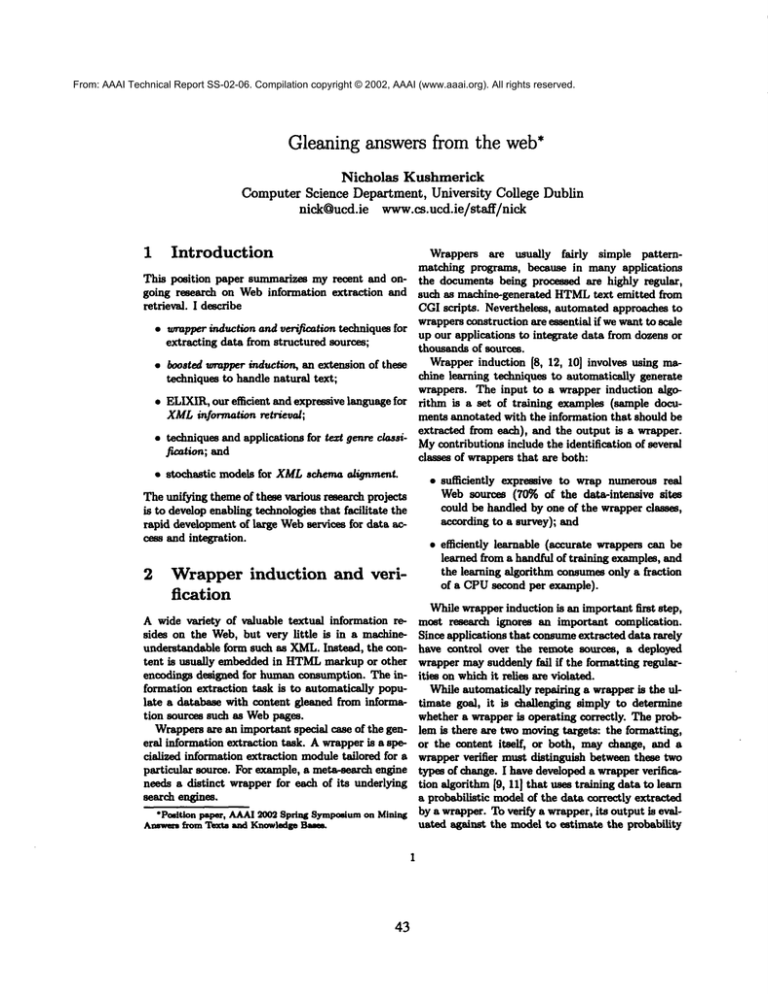
From: AAAI Technical Report SS-02-06. Compilation copyright © 2002, AAAI (www.aaai.org). All rights reserved.
Gleaning answers from the web*
Nicholas Kushmerick
ComputerScience Department, University College Dublin
nick@ucd.ie www.cs.ucd.ie/staff/nick
1
Introduction
This position paper summarizes my recent and ongoing research on Webinformation extraction and
retrieval. I describe
¯ wrapper induction and verification techniques for
extracting data from structured sources;
¯ boosted wrapper induction, an extension of these
techniques to handle natural text;
¯ ELIXIR,our efficient and expressive language for
XMLinformation retrieval;
¯ techniques and applications for text genre classification; and
¯ stochastic
models for XMLschen~ d/gnment.
The unifying theme of these various research projects
is to develop enabling technologies that facilitate the
rapid development of large Webservices for data access and integration.
2
Wrapper
fication
induction
and
veri-
A wide variety of valuable textual information resides on the Web, but very little is in a machine
understandable form such aa XML.Instead, the content is usually embedded in HTMLmarkup or other
encodings designed for human consumption. The information extraction task is to automatically populate a database with content gleaned from information sources such as Webpages.
Wrappers are an important special case of the general information extraction task. A wrapper is a specialized information extraction module tailored for a
particular source. For example, a meta-search engine
needs a distinct wrapper for each of its underlying
search e~i,es.
"Position
paper, AAAI 2002 Spring Symposium on Mining
Answe~ from Texts and Knowledge B,--,~;
43
Wrappers are usually fairly
simple patternmatching programs, because in many applications
the documents being processed are highly regular,
such as machine-generated HTMLtext emitted from
CGI scripts. Nevertheless, automated approaches to
wrappers construction are essential if we want to scale
up our applications to integrate data from dozens or
thousands of sources.
Wrapper induction [8, 12, 10] involves using machine learning techniques to automatically generate
wrappers. The input to a wrapper induction algorithm is a set of training examples (sample documents annotated with the information that should be
extracted from each), and the output is a wrapper.
Mycontributions include the identification of several
classes of wrappers that are both:
¯ sufficiently
expressive to wrap numerous real
Web sources (70~ of the data-intensive
sites
could be handled by one of the wrapper classes,
according to a survey)~ and
¯ efficiently learnable (accurate wrappers can be
learned from a handful of training examples, and
the learning algorithm consumes only a fraction
of a CPUsecond per example).
While wrapper induction is an important first step,
most research ignores an important complication.
Since applications that consumeextracted data rarely
have control over the remote sources, a deployed
wrapper may suddenly fail if the formatting regularities on whichit relies are violated.
While automatically repairing a wrapper is the ultimate goal, it is challenging simply to determine
whether a wrapper is operating correctly. The problem is there are two moving targets: the formatting,
or the content itself,
or both, may change, and a
wrapper verifier must distinguish between these two
types of change. I have developed a wrapper verification algorithm [9, 11] that uses training data to learn
a probabilietic model of the data correctly extracted
by a wrapper. To verify a wrapper, its output is evaluated against the model to estimate the probability
that the wrapper is operating correctly.
3
Boosted wrapper induction
While the wrapper induction algorithms were designed for regularly formatted documents such as
machine-generated HTML,we wondered whether the
approach could be extended to natural text such as
newspaper articles or email messages. The extraction
rules learned by wrapper induction are simple contextual patterns such as "extract ’<b>anything</b>’as
a telephone number. Can information be successfully extracted from natural text by composing many
such simple rules (eg, "extract ’call me at anything
before’ or ’phone: anything (home)’ as a telephone
number")?
To explore this possibility, we used boosting, a machine learning technique for improving the accuracy
of learning algorithms with high accuracy but low
coverage, such as the simple wrapper induction algorithms. The result is the boosted wrapper induction algorithm [7], which is competitive at numerous
real-world extraction tasks with state-of-the-art algorithms (including hidden Markov models and several
rule-learning algorithms), and superior in many.
A demonstration of boosted wrapper induction is
available at www.smi.ucd.ie/bwi.
4
XMLinformation
retrieval
XMLhas emerged as a powerful standard for the interchange of structured documents. Given its structured nature, XMLhas given rise to new languages
for querying, traversing, filtering and transforming
XMLcontent.
These languages have been developed by database
rather than information retrieval researchers, so the
languages do not support ranked or graded queries
in the spirit of traditional information retrieval. For
example, one can use existing query languages to retrieve sections of an XMLdocument containing exactly the phrase "engineering reports", but it is impossible to rank these results by the degree to which
they satisfy the query (e.g., sections that contain just
one of the terms, or variants such as "engineer" or
"reporting" should be retrieved at lower rank).
Wefill this gap with ELIXIR[3, 1, 2], an efficient
and expressive
language for XMLinformation
retrieval.
ELIXIRextends existing XMLquery technology with a graded textual similarity operator. Unlike related efforts, our language efficiently supports
similarity joins, an essential capability for data in-
44
tegration applications with noisy textual identifiers.
For example,to identify possible duplicates in a list of
book titles, one could use an ELIXIRsimilarity join
to identify pairs of titles that are mutually similar.
A demonstration
of ELIXIR is available
at
www.smi.ucd.ie/elixir.
5
Text genre classification
Most text classification
research has focused on objective dasses reflecting documenttopics or concepts,
such as classifying newspaperarticles into ’financial’,
’sports’, etc. In contrast, we are examiningsubjective
genre classification tasks such as whether a newspaper article expresses ’opinions’ as opposed to ’facts’,
whether a product review is ’positive’ or ’negative’,
whether an article is ’detailed’ or ’superficial’, the
amount of technical knowledge assumed by a document’s author, etc.
Existing text classification
algorithms exploit
words that reliably indicate the correct class. Our
investigation [5, 6, 4] suggests that such term-based
techniques are inaccurate for our subjective tasks.
Instead, we use shallow natural language processing
techniques such as part-of-speech tagging and estimates of term topicality to derive document features
that yield accurate classification.
Our experiments
in the newspaper domain confirm that part-of-speech
tags yield significantly better performance than term
features.
We our employing our techniques in two applications: information filtering in heterogeneous digital libraries, and the visualization of information retrieval search results.
A demonstration of our text classification
techniques is available at www~mi.ucd.ie/hyppia.
6
Stochastic
models
schema integration
for
XML
The well-known database schema integration challenge is that data retrieved from heterogeneous
sources can not be integrated without a mapping
from the remote schemas to some global or mediated
schema.
We focus on one particular
task: automaticaUy constructing mappings between heterogeneous
sources of semi-structured XMLdata. For example,
if you export your Rolodex data with <name> and
<address> tags, but I use <Jmeno> and <ullce>,
our data can’t be integrated without knowing that
<naue>-----<Jmono> and <addrese>ffi<u3.1ce>. This
problem has received some attention recently, but
these efforts largely ignores the constraints imposed
by XML’snested structure.
To address this problem, we are developing a novel
stochastic finite-state
model called the Stochastic
Document Markup Model. SDMMsare similar to
hidden Markov models: they contain states linked by
stochastic transitions, and states emit tokens according to a given distribution. Somestates (the "tag"
states) emit XMLtags such as <name> or <jmeno>,
while others emit the actual element contents (eg, 12
Main St).
An essential
difference
between SDMMsand
HMMsis that at decoding time we do not know
the tag states’ emission distributions. For example,
we know that a given state emits an XMLtag for
~.amen--but we don’t know what that tag is! Furthermore, in decoding, we demand a path that is
both cyclic (ensuring only well-formed XMLis generated) and consistent (ag, if the "name"state emits
<Jleno>, then no other tag can be emitted subsequently). Since SDMM
decoding appears harder than
for HMMs,we are examining heuristic
approximations, such as finding a path with probability within
a constant factor of optimal, or paths that are "almost" consistent or properly nested.
[4] M. Dimitrova, A. Finn, N. Kushmerick, and
B. Smyth. Web genre visualization.
2002.
Submitted to Conference on Human Factors in
Computi,9 Systems.
[5] A. Finn, N. Kushmerick, and B. Smyth. Fact
or fiction: Ccontent classification for digital libraries.
In Proc. NSF/DELO$ Workshop on
Personaliza~ion
and R~mmender S~tems in
Digital Libraries, 2001.
[6] A. Finn, N. Knshmerick, and B. Smyth. Genre
classification
and donmin transfer for information filtering.
In Proc. European Colloqium on
Information Retrievd Resmrch, 2002.
[7] D. Freitag and N. Kushmerick. Boosted wrapper
induction. In Proc. 17th Nat. Con/. AI, pages
577--583, 2000.
[8] N. Kusbmerick. Wrapper Induction for lnforma.
tion Extraction, PhDthesis, Univ. of Washington, 1997.
[9] N. Kushmerich. Regression testing for wrapper
maintenance. In Pro,:. 16th Nat. Conf. AI, pages
74-79,1999.
[I0]N. Kashmerick.
Wrapperinduction:
Efficiency
and expressiveness. J. Artificial Intdligence,
118(1-2):15--68, 2000.
Acknowledgments. This research was funded by
~’ants from Enterprise Ireland, the US Office of
World
Naval Research, the US National Science Foundation, [11] N. Kushmerick. Wrapper verification.
Wide Web Jourm~ 3(2):79-94, 2000.
and a University College Dublin President’s Research
Award.As listed in the bibliography, I amgrateful to
N. Kushmerick, D. Weld, and R. Doorenbce.
my many colleagues at the University of Washington [12]
Wrapper induction for information extraction.
and University College Dublin.
In Proc 15th Int. Joint Conf. AI, pages 729735,1997.
References
[I] T. Chinenyanga and N. Kushmerick. An efficient and expressive language for XMLinformation retrieval.
Journa/of the American Society
for Information Science and Technology, 2001.
In press.
[2] T. Chinenyanga and N. Kushmerick. Expressive
and efficient ranked querying of XMLdata. In
Prec. ACMSIGMODWorl~hop or, the Weband
D-~bases, 2001.
[3] T. Chinenyanga and N. Kushmerick. Expressive
retrieval
from XMLdocuments. In Proe. ACM
Int. Conf. Research and Development in Information Retrieva4 pages 163-171, 2001.
45



